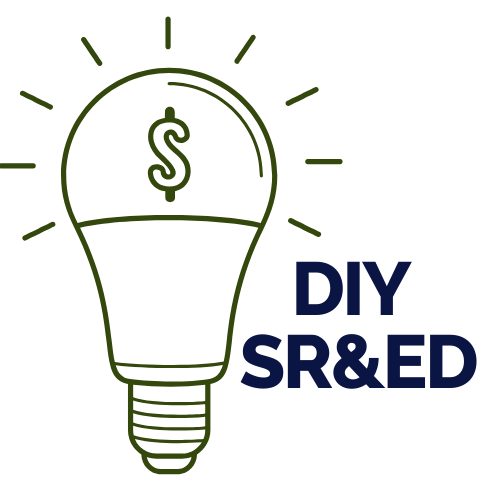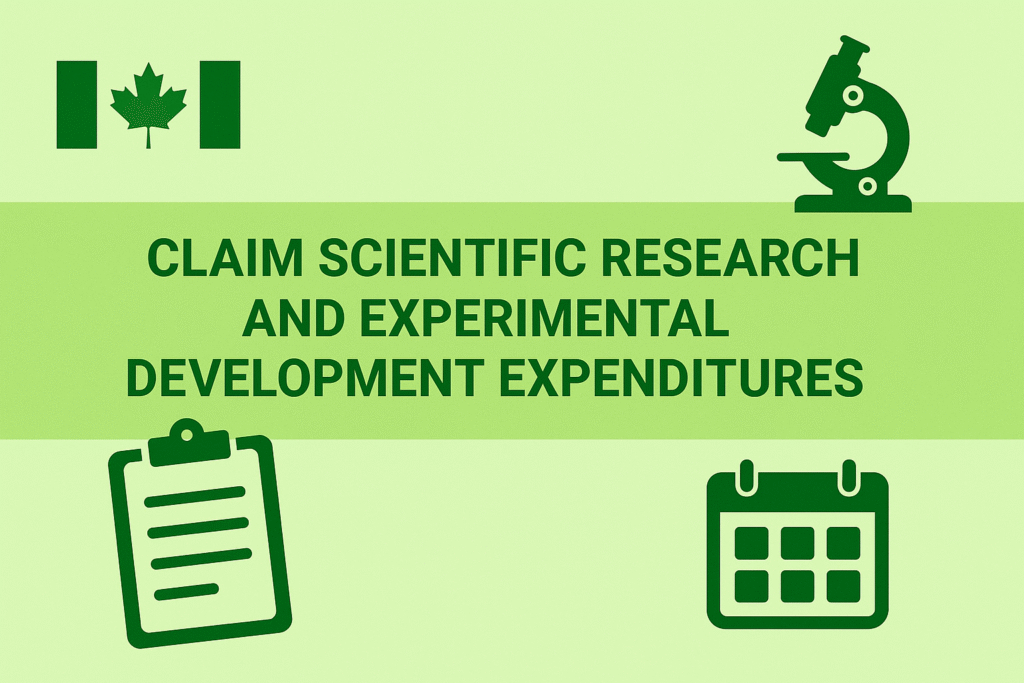Wondering how to apply for SR&ED as a startup? You’re in the right place.
Filing for SR&ED (Scientific Research and Experimental Development) isn’t just for big tech or lab-coated scientists. If you’re a Canadian startup building, testing, or solving tough technical challenges—you might be leaving serious government money on the table.
This guide breaks down how to apply for SR&ED step-by-step—no fluff, no consultants, just practical advice for founders who want to claim their R&D tax credits with confidence.
1. First, What Does an SR&ED Claim Actually Include?
Your SR&ED application has two main parts:
- The Technical Story (Form T661, Part 2): You’ll explain the R&D project—what problem you were trying to solve, how you tackled it, and what breakthroughs (or fails) came out of it.
- The Numbers (T661 + tax schedules): This is where you show how much you spent on R&D—like salaries, materials, contractors—and calculate your tax credit.
2. How to Nail the Technical Questions (a.k.a. The “3Qs”)
The CRA uses three questions to figure out whether your R&D work qualifies. Here’s how to answer them in a way that actually gets approved:
Q1: What Tech Problem Were You Trying to Solve?
This is your chance to show the CRA that your R&D wasn’t just routine work—it tackled a real technical challenge. You need to explain what problem your project was trying to solve, why off-the-shelf solutions didn’t cut it, and what made this issue tricky from a scientific or tech standpoint.
Think of it like this: You’re showing there was a knowledge gap in your industry—and your team rolled up their sleeves to figure it out.
✅ Strong Answer Example:
“We were building an AI model to detect plant diseases in real time. The challenge? Existing models couldn’t tell the difference between early-stage infections and normal crop changes—especially at scale. Nothing in published research offered a reliable fix, so we had to push beyond what was already known.”
🚫 Weak Answer Example:
“We built an AI model to monitor crops more efficiently.”
(Too vague—this doesn’t explain the real challenge or what made the work innovative.)
💡 Think of it this way: The 3Qs prove why your project qualifies, while the rest of the forms calculate how much you get back.
Q2: How Did You Try to Solve the Problem?
When applying for SR&ED, the CRA wants to see that your work wasn’t just guesswork or routine development—it followed a structured, experimental process. That means documenting your hypotheses, your testing process, and even your failures (yes, failed experiments still count!).
Think of this part as telling the story of how your team tackled a tough problem through trial, iteration, and real R&D effort.
✅ Good Answer Example:
“We tested three different deep-learning models (CNN, RNN, and transformer-based architectures) on various datasets. We experimented with feature extraction techniques to improve early-stage disease detection accuracy, adjusting hyper-parameters and optimizing model weights. Each iteration was tested against ground-truth field data.”
🚫 Weak Answer Example:
“We trained a machine learning model and improved it over time.” (No mention of specific experiments or problem-solving.)
💡 Why This Matters:
If you’re figuring out how to apply for SR&ED, this is where you prove your work was real R&D—not just building a product. Be specific, show the process, and don’t shy away from what didn’t work.
Q3: What Did You Discover or Try to Discover?
Here’s the good news for startups: you don’t need a “successful” outcome to qualify for SR&ED. Even if your project didn’t hit the mark, what matters is the technical knowledge you gained along the way.
When applying for SR&ED, this is your chance to highlight the breakthroughs, insights, or improvements your team made—whether that’s better performance, higher accuracy, or just proving something didn’t work.
✅ Good Answer Example:
“We discovered that incorporating infrared imagery significantly improved early-stage disease detection accuracy. This insight could inform future AI-based agricultural solutions and address a major industry gap.”
🚫 Weak Answer Example:
“We successfully built an AI-powered crop monitoring system.” (Too generic—no insight into what was learned or improved.)
💡 Why This Matters:
If you’re figuring out how to apply for SR&ED as a startup, remember this: CRA cares more about learning and experimentation than about perfect outcomes. Focus on the new knowledge your team developed—even from failure—and how it moves your tech forward.


3. The Money Part: Reporting Your SR&ED-Eligible Costs
Now that your story is solid, let’s talk about how to get your refund.
Step 1: Track Your SR&ED-Eligible Expenses (Yes, You Probably Have More Than You Think)
Before you fill out any forms, you need to figure out what R&D costs you can claim. The good news? If your startup is actively building or testing something technical, a bunch of your everyday costs may already qualify.
Here’s what to gather:
- Salaries & Wages
If your team is doing hands-on R&D work—developers, engineers, scientists—you can claim their pay. Make sure you’ve got T4s, pay stubs, and timesheets to back it up. - Subcontractor Costs
Paid a Canadian contractor for R&D help? That’s eligible too. Grab their invoices and statements of work (and remember—you can only claim 80% of these costs under SR&ED rules). - Third-Party Research
If you worked with universities, colleges, research institutes, or research hospitals in Canada, those payments may count. You’ll need invoices, research agreements, and proof of payment. - Materials Used in R&D
From chemicals to circuit boards, if it got used up or transformed during your experiments, it’s claimable. Keep receipts and lab/test logs. - Overhead Costs
You can go two ways here:- Proxy method: Add 55% on top of eligible salaries—simple and popular for startups.
- Traditional method: Manually track actual costs like rent and utilities (only worth it if your overhead is high).
💡 Pro tip: Don’t guess—keep a folder for every cost category from day one. It’ll make your claim smoother and your refund bigger.
Step 2: Add Up Your Eligible Costs and Plug Them into Form T661 (No Consultant Needed)
Time to tell the CRA what you spent on R&D—and how it breaks down. Don’t worry, this part is just about matching your numbers to the right lines on the form. Here’s how it works:
📝 Form T661 – Part 3: Reporting Your SR&ED Expenses
- Lines 300–315 → Drop in the salaries and wages for your R&D team (think: engineers, data scientists, developers working on the tech).
- Lines 320 & 325 → Enter the cost of materials that were either used up (consumed) or transformed during experiments (like prototypes, chemicals, etc.).
- Lines 340 & 345 → Add your subcontractor costs—you’ll enter the full amount here, and CRA will apply the 80% adjustment later (on Line 529).
- Line 360 → Only for teams using the traditional method: report your overhead costs here (rent, utilities, etc.). If you’re using the proxy method, skip this—CRA will calculate the 55% bump in Part 5.
- Line 370 → List any third-party payments (universities, research institutes). You’ll also need to fill out Form T1263 to back this up.
💡 Pro Tip: Need a hand filling this out? Check out our startup-friendly Form T661 guideline —no finance degree required.
📝 Form T661 – Part 4: Adjustments & Deductions
- Lines 513–544 → Report any deductions, like grants you received, previous year’s SR&ED credits, or the 20% rule for third-party/subcontractor costs.
- Line 502 → This is where your proxy method adjustment goes (calculated in Part 5).
👉 T661 Form Guide is a guide from DIY SR&ED for Canadian startup founders who are tackling their SR&ED claim solo — no consultants, just DIY.
Step 3: Don’t Forget the Extra Forms (More Credits = More Cash Back)
If you’re learning how to apply for SR&ED and want to get the maximum refund, these extra forms are key. Once your T661 is done, it’s time to calculate how much you’re getting back—from both the federal and provincial governments.
A. Schedule 31 – Your Federal Refund Booster
- Schedule 31 is where you calculate your Federal Investment Tax Credit (ITC).
- It takes the costs you reported on your T661 and turns them into actual $$—based on your status (CCPC or not).
- Don’t skip this one; it’s required for your federal refund.
B. Provincial R&D Tax Credit Forms (Ontario Example)
If your startup operates in Ontario, you’ll likely need to file these extra schedules:
- Schedule 508 – Ontario Research and Development Tax Credit (ORDTC)
- Schedule 566 – Ontario Innovation Tax Credit (OITC)
- Schedule 568 – Ontario Business Research Institute Tax Credit (OBRITC)
(This one’s required if you worked with universities, colleges, or research institutions.)
💡 Outside Ontario? Other provinces like BC, Quebec, and Alberta have their own versions of these forms. Reach out and we’ll point you in the right direction.

Have a question?
Send us a message—we’re here to assist!
4. How to Actually Submit It
When you’re figuring out how to apply for SR&ED, the final step is submitting your claim with your T2 corporate tax return. This is where all those forms (T661, Schedules 31, etc.) come together.
Deadline: You’ve got 18 months from the end of your fiscal year to file.
How to file your SR&ED claim:
- Using tax software: Perfect if you’re going full DIY.
- Through your accountant: Even if you handled the SR&ED part yourself, they can submit everything with your tax return.
5. What Happens After You Hit Submit? (CRA Review & Timeline)
So you’ve filed—nice work! Now here’s what to expect while your SR&ED claim makes its way through the CRA pipeline:
- Processing Time: It usually takes 1 to 3 months for the CRA to review your SR&ED claim. Be patient—but keep an eye on your inbox just in case they reach out.
- Review Requests: If your claim is selected for a review (totally normal), the CRA might ask for extra documentation. This is where your clean records and detailed answers really pay off.
- Refund Payment: Once approved, your SR&ED refund lands directly in your startup’s bank account. No complicated steps—just a nice cash boost.
💡 Pro Tip for First-Timers:
If it’s your first time filing, the CRA will likely offer a short intro call (not an audit!) through their First-Time Claimant Advisory Service. Think of it as a crash course to help you avoid mistakes. If your 3Qs are solid and your docs are in order, you’ll breeze through it.
6. Common Mistakes Startups Make When Figuring Out How to Apply for SR&ED
You’re DIYing your SR&ED claim like a pro—but here are some easy-to-avoid mistakes that could cost you big:
- 🚫 Weak Answers to the 3Qs
These three questions are the heart of your claim. Vague, generic answers = smaller refunds (or worse, rejection). Be specific, technical, and honest about the challenges you tackled. - 🚫 Incomplete Documentation
If the CRA asks for receipts, logs, or time-tracking—and you don’t have them—it’s game over. Keep clean records from day one. Good documentation = more money back. - 🚫 Missed Deadlines
You have 18 months from your fiscal year-end to file your SR&ED claim. Miss that window, and you leave serious money on the table.
💡 Startup Tip: When you know how to apply for SR&ED the right way, you’ll save time, boost your refund, and stay 100% compliant.
Final Thoughts: How to Apply for SR&ED Like a Startup Pro
Nailing the 3 Key Questions is your secret weapon—get those right, and the rest is just filling in forms.
When you know how to apply for SR&ED yourself, you save thousands (yep, no need to hand over 20% to consultants).
Keep your documentation clean, explain your R&D clearly, and file with confidence. You’ve got this—and we’re here if you need backup.
Ready to Maximize Your SR&ED Refund?
Check out our Services Page to see how we help startups DIY their SR&ED claim without the consultant price tag.
Next Up:
👉 Audit-Proofing Your SR&ED Claim In our next post, we’ll show you how to structure your claim properly and how to defend against audits.
Read More
- T661 Form Guide: How to File Your First SR&ED Claim
- SR&ED Audit: How to Prepare Your Startup for a Smooth CRA Review
- How to Apply for SR&ED: A Startup-Friendly Step-by-Step Guide
- SR&ED Documentation: What Startups Need & How to Stay Audit-Ready
- How to Maximize Your SR&ED Claim: Startup-Friendly Strategies That Follow SR&ED Guidelines




